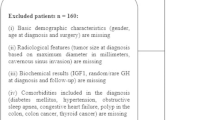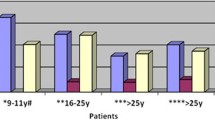Abstract
Background
Acromegaly is a rare disease resulting in clinical sequelae with significant morbidity and mortality due to the central tumor mass effect and prolonged growth hormone (GH) hypersecretion.
Objectives
The goal is to describe the epidemiology, clinical features, presence of comorbidities, and treatment outcomes of acromegaly in Saudi Arabia.
Methods
Data was collected through a retrospective review of the charts of all patients diagnosed with acromegaly from nine major hospitals in Saudi Arabia over a period of more than 25 years.
Results
A total of 195 patients (116 males and 79 females), with a mean age at diagnosis of 43 ± 12 (males) and 46 ± 14 years (females), from nine major hospitals were identified and included in the analysis. All cases were caused by pituitary adenomas, of which 92.4% were macroadenomas. Headache, coarse facial features, acral growth, and sweating/oily skin were by far the most frequent presenting complaints. The most common comorbidities were diabetes mellitus (51.7%), followed by hypertension (50%) and visual field defect (30.5%). The vast majority (95%) of patients were treated surgically (98%). Twenty-four percent also received radiotherapy, and 74.4% received medical therapy. When stringent criteria were applied for assessment of outcomes of therapy, 28.7% of the patients were cured and 30.1% had their disease under control, while 28.7% were found to have active disease despite receiving multimodal therapy.
Conclusions
Our findings highlight the need for a national acromegaly registry to enable early identification, evaluation, and selection of the best therapeutic approaches to improve the outcome and remission rate of the disease.
Similar content being viewed by others
References
Katznelson L, Atkinson JL, Cook DM, Ezzat SZ, Hamrahian AH, Miller KK (2011) American Association of Clinical Endocrinologists medical guidelines for clinical practice for the diagnosis and treatment of acromegaly--2011 update. Endocr Pract 17(Suppl 4):1–44
Holdaway IM, Rajasoorya C (1999) Epidemiology of acromegaly. Pituitary 2(1):29–41
Schneider HJ, Sievers C, Saller B, Wittchen HU, Stalla GK (2008) High prevalence of biochemical acromegaly in primary care patients with elevated IGF-1 levels. Clin Endocrinol 69(3):432–435. https://doi.org/10.1111/j.1365-2265.2008.03221.x
Bush ZM, Vance ML (2008) Management of acromegaly: is there a role for primary medical therapy? Rev Endocr Metab Disord 9(1):83–94. https://doi.org/10.1007/s11154-007-9061-1
el-Andere W, Lerario AC, Netto DG, Wajchenberg BL (1995) Erythrocyte insulin-like growth factor-I receptor evaluation in normal subjects, acromegalics, and growth hormone-deficient and insulin-dependent diabetic children. Metabolism 44(7):923–928
Alexander L, Appleton D, Hall R, Ross WM, Wilkinson R (1980) Epidemiology of acromegaly in the Newcastle region. Clin Endocrinol 12(1):71–79
Nachtigall L, Delgado A, Swearingen B, Lee H, Zerikly R, Klibanski A (2008) Changing patterns in diagnosis and therapy of acromegaly over two decades. J Clin Endocrinol Metab 93(6):2035–2041. https://doi.org/10.1210/jc.2007-2149
Orme SM, McNally RJ, Cartwright RA, Belchetz PE (1998) Mortality and cancer incidence in acromegaly: a retrospective cohort study. United Kingdom acromegaly study group. J Clin Endocrinol Metab 83(8):2730–2734. https://doi.org/10.1210/jcem.83.8.5007
Bates AS, Van't Hoff W, Jones JM, Clayton RN (1993) An audit of outcome of treatment in acromegaly. Q J Med 86(5):293–299
Etxabe J, Gaztambide S, Latorre P, Vazquez JA (1993) Acromegaly: an epidemiological study. J Endocrinol Investig 16(3):181–187. https://doi.org/10.1007/bf03344942
Rajasoorya C, Holdaway IM, Wrightson P, Scott DJ, Ibbertson HK (1994) Determinants of clinical outcome and survival in acromegaly. Clin Endocrinol 41(1):95–102
Jenkins PJ, Besser M (2001) Clinical perspective: acromegaly and cancer: a problem. J Clin Endocrinol Metab 86(7):2935–2941. https://doi.org/10.1210/jcem.86.7.7634
Swearingen B, Barker FG 2nd, Katznelson L, Biller BM, Grinspoon S, Klibanski A, Moayeri N, Black PM, Zervas NT (1998) Long-term mortality after transsphenoidal surgery and adjunctive therapy for acromegaly. J Clin Endocrinol Metab 83(10):3419–3426. https://doi.org/10.1210/jcem.83.10.5222
Melmed S (2001) Acromegaly and cancer: not a problem. J Clin Endocrinol Metab 86:2929–2934
Giustina A, Barkan A, Casanueva FF, Cavagnini F, Frohman L, Ho K, Veldhuis J, Wass J, Von Werder K, Melmed S (2000) Criteria for cure of acromegaly: a consensus statement. J Clin Endocrinol Metab 85(2):526–529. https://doi.org/10.1210/jcem.85.2.6363
Jane JA Jr, Starke RM, Elzoghby MA, Reames DL, Payne SC, Thorner MO, Marshall JC, Laws ER Jr, Vance ML (2011) Endoscopic transsphenoidal surgery for acromegaly: remission using modern criteria, complications, and predictors of outcome. J Clin Endocrinol Metab 96(9):2732–2740. https://doi.org/10.1210/jc.2011-0554
Starke RM, Raper DM, Payne SC, Vance ML, Oldfield EH, Jane JA Jr (2013) Endoscopic vs microsurgical transsphenoidal surgery for acromegaly: outcomes in a concurrent series of patients using modern criteria for remission. J Clin Endocrinol Metab 98(8):3190–3198. https://doi.org/10.1210/jc.2013-1036
Cozzi R, Montini M, Attanasio R, Albizzi M, Lasio G, Lodrini S, Doneda P, Cortesi L, Pagani G (2006) Primary treatment of acromegaly with octreotide LAR: a long-term (up to nine years) prospective study of its efficacy in the control of disease activity and tumor shrinkage. J Clin Endocrinol Metab 91(4):1397–1403. https://doi.org/10.1210/jc.2005-2347
Bex M, Abs R, T'Sjoen G, Mockel J, Velkeniers B, Muermans K, Maiter D (2007) AcroBel--the Belgian registry on acromegaly: a survey of the 'real-life' outcome in 418 acromegalic subjects. Eur J Endocrinol 157(4):399–409. https://doi.org/10.1530/eje-07-0358
Portocarrero-Ortiz LA, Vergara-Lopez A, Vidrio-Velazquez M, Uribe-Diaz AM, Garcia-Dominguez A, Reza-Albarran AA, Cuevas-Ramos D, Melgar V, Talavera J, Rivera-Hernandez AJ et al (2016) The Mexican acromegaly registry: clinical and biochemical characteristics at diagnosis and therapeutic outcomes. J Clin Endocrinol Metab 101(11):3997–4004. https://doi.org/10.1210/jc.2016-1937
Saudi National Portal. July 2019. 21. https://www.saudi.gov.sa/wps/portal/snp/pages/saudiReportsAndStatistics
Kwon O, Song YD, Kim SY, Lee EJ (2013) Nationwide survey of acromegaly in South Korea. Clin Endocrinol 78(4):577–585. https://doi.org/10.1111/cen.12020
Schofl C, Franz H, Grussendorf M, Honegger J, Jaursch-Hancke C, Mayr B, Schopohl J (2013) Long-term outcome in patients with acromegaly: analysis of 1344 patients from the German Acromegaly Register. Eur J Endocrinol 168(1):39–47. https://doi.org/10.1530/eje-12-0602
Arosio M, Reimondo G, Malchiodi E, Berchialla P, Borraccino A, De Marinis L, Pivonello R, Grottoli S, Losa M, Cannavo S et al (2012) Predictors of morbidity and mortality in acromegaly: an Italian survey. Eur J Endocrinol 167(2):189–198. https://doi.org/10.1530/eje-12-0084
Mestron A, Webb SM, Astorga R, Benito P, Catala M, Gaztambide S, Gomez JM, Halperin I, Lucas-Morante T, Moreno B et al (2004) Epidemiology, clinical characteristics, outcome, morbidity and mortality in acromegaly based on the Spanish acromegaly registry (Registro Espanol de Acromegalia, REA). Eur J Endocrinol 151(4):439–446
Sesmilo G, Gaztambide S, Venegas E, Pico A, Del Pozo C, Blanco C, Torres E, Alvarez-Escola C, Fajardo C, Garcia R et al (2013) Changes in acromegaly treatment over four decades in Spain: analysis of the Spanish Acromegaly Registry (REA). Pituitary 16(1):115–121. https://doi.org/10.1007/s11102-012-0384-x
Beauregard C, Truong U, Hardy J, Serri O (2003) Long-term outcome and mortality after transsphenoidal adenomectomy for acromegaly. Clin Endocrinol 58(1):86–91
Cozzi R, Barausse M, Lodrini S, Lasio G, Attanasio R (2003) Estroprogestinic pill normalizes IGF-I levels in acromegalic women. J Endocrinol Investig 26(4):347–352. https://doi.org/10.1007/bf03345183
Vallette S, Serri O (2010) Oral estroprogestin: an alternative low cost therapy for women with postoperative persistent acromegaly? Pituitary 13(4):311–314. https://doi.org/10.1007/s11102-010-0236-5
Chalmers RJ, Ead RD, Beck MH, Dewis P, Anderson DC (1983) Acne vulgaris and hidradenitis suppurativa as presenting features of acromegaly. Br Med J (Clin Res Ed) 287(6402):1346–1347. https://doi.org/10.1136/bmj.287.6402.1346-a
Al-Rubeaan K, Bawazeer N, Al Farsi Y, Youssef AM, Al-Yahya AA, AlQumaidi H, Al-Malki BM, Naji KA, Al-Shehri K, Al Rumaih FI (2018) Prevalence of metabolic syndrome in Saudi Arabia - a cross sectional study. BMC Endocr Disord 18(1):16. https://doi.org/10.1186/s12902-018-0244-4
Alqarni SSM (2016) A review of prevalence of obesity in Saudi Arabia. J Obes Eat Disord 2:2. https://doi.org/10.21767/2471-8203.100025
Clemmons DR, Van Wyk JJ, Ridgway EC, Kliman B, Kjellberg RN, Underwood LE (1979) Evaluation of acromegaly by radioimmunoassay of somatomedin-C. N Engl J Med 301(21):1138–1142. https://doi.org/10.1056/nejm197911223012102
Schneider HJ, Friedrich N, Klotsche J, Schipf S, Nauck M, Volzke H, Sievers C, Pieper L, Marz W, Wittchen HU et al (2011) Prediction of incident diabetes mellitus by baseline IGF1 levels. Eur J Endocrinol 164(2):223–229. https://doi.org/10.1530/eje-10-0963
Sherlock M, Ayuk J, Tomlinson JW, Toogood AA, Aragon-Alonso A, Sheppard MC, Bates AS, Stewart PM (2010) Mortality in patients with pituitary disease. Endocr Rev 31(3):301–342. https://doi.org/10.1210/er.2009-0033
Dekkers OM, Biermasz NR, Pereira AM, Romijn JA, Vandenbroucke JP (2008) Mortality in acromegaly: a meta-analysis. J Clin Endocrinol Metab 93(1):61–67. https://doi.org/10.1210/jc.2007-1191
Funding
This work was supported by a grant from the research center of King Fahad Medical City, Riyadh, Saudi Arabia.
Author information
Authors and Affiliations
Corresponding author
Ethics declarations
Conflict of interest
The authors declare that they have no conflict of interest.
Ethical approval
The study was approved by a research ethics committee of the King Fahad Medical City (KFMC) research center, Riyadh and King Faisal Specialist Hospital and Research Center (KFSH&RC), Riyadh, Saudi Arabia.
Informed consent
Not applicable.
Additional information
Publisher’s note
Springer Nature remains neutral with regard to jurisdictional claims in published maps and institutional affiliations.
Rights and permissions
About this article
Cite this article
AlMalki, M.H., Ahmad, M.M., Buhary, B.M. et al. Clinical features and therapeutic outcomes of patients with acromegaly in Saudi Arabia: a retrospective analysis. Hormones 19, 377–383 (2020). https://doi.org/10.1007/s42000-020-00191-0
Received:
Accepted:
Published:
Issue Date:
DOI: https://doi.org/10.1007/s42000-020-00191-0




